The number of Shinto shrines in Japan today has been estimated at more than 150,000.[1] Single structure shrines are the most common. Shrine buildings might also include oratories (in front of main sanctuary), purification halls, offering halls called heiden (between honden and haiden), dance halls, stone or metal lanterns, fences or walls, torii and other structures.[2] The term "National Treasure" has been used in Japan to denote cultural properties since 1897.[3] The definition and the criteria have changed since the inception of the term. The shrine structures in this list were designated national treasures when the Law for the Protection of Cultural Properties was implemented on June 9, 1951. As such they are eligible for government grants for repairs, maintenance and the installation of fire-prevention facilities and other disaster prevention systems. Owners are required to announce any changes to the National Treasures such as damage or loss and need to obtain a permit for transfer of ownership or intended repairs.[4] The items are selected by the Ministry of Education, Culture, Sports, Science and Technology based on their "especially high historical or artistic value".[5][6] This list presents 42[nb 1][nb 2] entries of national treasure shrine structures from 12th-century Classical Heian period to the early modern 19th-century Edo period. The number of structures listed is actually more than 42, because in some cases groups of related structures are combined to form a single entry. The structures include main halls (honden), oratories (haiden), gates, offering halls (heiden), purification halls (haraedono) and other structures associated with shrines.[6]
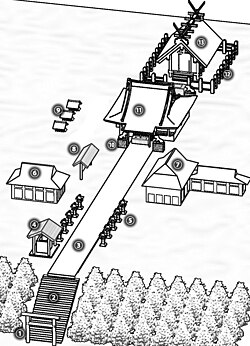
The practice of marking sacred areas began in Japan as early as the Yayoi period (from about 500 BC to 300 AD) originating from primal religious beliefs. Features in the landscape such as rocks, waterfalls, islands, and especially mountains, were places believed to be capable of attracting kami, and subsequently were worshiped as yorishiro.[7] Originally, sacred places may have been simply marked with a surrounding fence and an entrance gate or torii.[8] Later, temporary structures similar to present day portable shrines[9] were constructed to welcome the gods to the sacred place, which eventually evolved into permanent buildings that were dedicated to the gods. Ancient shrines were constructed according to the style of dwellings (Izumo Taisha)[7][10] or storehouses (Ise Grand Shrine).[7][8] The buildings had gabled roofs, raised floors, plank walls, and were thatched with reed or covered with hinoki cypress bark.[8] Such early shrines did not include a space for worship.[7] Three important forms of ancient shrine architectural styles exist: taisha-zukuri,[ex 1] shinmei-zukuri[ex 2] and sumiyoshi-zukuri.[ex 3][1][9] They are exemplified by Izumo Taisha, Nishina Shinmei Shrine and Sumiyoshi Taisha,[11] respectively, and date from before 552 AD.[12] According to the tradition of Shikinen sengū-sai (式年遷宮祭), the buildings or shrines were faithfully rebuilt at regular intervals adhering to the original design. In this manner, ancient styles have been replicated through the centuries to the present day.[nb 3][10][13][14]
Beginning in the mid-6th century, as Buddhism was brought to Japan from Baekje, new styles of shrine architecture were introduced; today's Shinto shrine blueprint is of Buddhist origin.[15] The concept of temples as a place of assembly was applied to shrines. Spaces for worship were added in the form of extended roofs or worship halls (haiden) in addition to the main hall (honden).[7] The following stylistic elements of Buddhist temple architecture were assimilated and applied to Japanese shrines: column-base stones,[nb 4] brackets, curved roofs, painted surfaces, metal ornaments, corridors and pagodas.[7][8][16] At the end of the 8th century as architectural styles evolved, new elements were added as is evident in kasuga-zukuri[ex 4] (Kasuga Shrine and Hakusandō/Kasugadō at Enjō-ji), the flowing roof or nagare-zukuri[ex 5] (Shimogamo Shrine), hachiman-zukuri[ex 6] (Usa Shrine) and hiyoshi-zukuri[ex 7] (Hiyoshi Taisha).[17][18] The nagare-zukuri continues to be the more popular style, followed by the kasuga-zukuri.[7][14] The honden of Ujigami Shrine dates to this period.[19] At the end of the Heian period torii and fences were commonly replaced with two-storied gates and grand colonnades copied from temple architecture. The influence of the residential shinden-zukuri style of palaces and mansions is apparent in shrines such as Itsukushima Shrine.[20]
The auxiliary Marōdo Shrine at Itsukushima Shrine originates from the 13th-century Kamakura period, and the honden and haiden of the Kibitsu Shrine date from the 15th-century Muromachi period.[21] In the late 16th century and early 17th century, during the Momoyama period, gongen-zukuri was introduced as a new plan of building shrines. The main hall was joined to the oratory via a connecting structure called the ai-no-ma, derived from the hachiman-zukuri style. Examples of gongen-zukuri are the honden at Kitano Tenman-gū and Ōsaki Hachiman Shrine.[22] Tōshō-gū dates from the Edo period and was completed in 1636. It is a complex assembly of richly adorned shrines, temples and a mausoleum.[23] Such complexes are a result of the syncretism of Shinto and Buddhism which began to appear during the Heian period; Kitano Tenman-gū, built in 947 for the spirit of Sugawara no Michizane, was the first of these byō or jingū-ji.[7][24]
The 42[nb 1][nb 2] entries in the list consist of the following: main halls (honden), combined structures of honden, haiden with or without an ai-no-ma or heiden in between, oratories (haiden), offering halls (heiden), corridors, gates, fences, purification halls and other halls that are related to a shrine.

| Prefecture | City | National Treasures |
|---|---|---|
| Hiroshima | Hatsukaichi | 1[nb 1] |
| Kagawa | Sakaide | 1 |
| Kagoshima | Kirishima | 1 |
| Kumamoto | Hitoyoshi | 1[nb 2] |
| Kyoto | Kyoto | 6 |
| Uji | 2 | |
| Yawata | 1 | |
| Miyagi | Sendai | 1 |
| Nagano | Ōmachi | 1 |
| Nara | Nara | 2 |
| Tenri | 1 | |
| Uda | 1 | |
| Okayama | Okayama | 1 |
| Ōita | Usa | 1 |
| Osaka | Osaka | 1 |
| Sakai | 1 | |
| Saitama | Kumagaya | 1 |
| Shiga | Nagahama | 1 |
| Ryūō | 1 | |
| Yasu | 2 | |
| Ōtsu | 3 | |
| Shimane | Matsue | 1 |
| Taisha | 1 | |
| Shizuoka | Shizuoka | 1 |
| Tochigi | Nikkō | 6 |
| Tottori | Misasa | 1 |
| Yamaguchi | Shimonoseki | 1 |
| Period[nb 5] | National Treasures |
|---|---|
| Heian period | 2 |
| Kamakura period | 9[nb 1] |
| Muromachi period | 5 |
| Momoyama period | 8[nb 2] |
| Edo period | 18 |
The table's columns (except for Remarks and Images) are sortable pressing the arrow symbols.
| Name | Shrine | Remarks | Date | Location | Image |
|---|---|---|---|---|---|
| Ōsaki Hachimangū (大崎八幡宮, Ōsaki Hachiman-gū)[nb 6][25] | Ōsaki Hachimangū | Honden: 5×3, single-storied, irimoya style[ex 8] with shake shingles; Ishi-no-ma (石の間): 1×1, single-storied, ryōsage style[ex 9] with shake shingles; Haiden: 5×3 (7 ken along the front facade), single-storied, irimoya style,[ex 8] front with a chidori hafu bargeboard[ex 10] and a 5 ken step canopy with a nokikarahafu gable,[ex 11] shake shingles. Oldest existing gongen style[ex 12] complex |
Azuchi-Momoyama period, 1607 | Sendai, Miyagi 38°16′21″N 140°50′42″E / 38.27250°N 140.84500°E | 
|
| Main Hall (本殿, honden), Room of Stone (石の間, ishi no ma) and Oratory (拝殿, haiden)[nb 7][31] | Tōshō-gū | Honden: 5×5, irimoya style[ex 8] with a 1 ken step canopy on the back side; ishi-no-ma (石の間): 3×1, ryōsage style;[ex 9] Haiden: 9×4 (7 ken along the front facade), irimoya style,[ex 8] front with a chidori hafu bargeboard[ex 10] and a 3 ken step canopy with a nokikarahafu gable.[ex 11] All three structures are single-storied and have copper-tile roofing. |
early Edo period, 1636 | Nikkō, Tochigi 36°45′29″N 139°35′55″E / 36.75806°N 139.59861°E | 
|
| Yōmeimon (陽明門)[nb 8][31] | Tōshō-gū | 3×2, two-storied sangen-ikko (三間一戸) gate in irimoya style[ex 8] with nokikarahafu gables[ex 11] in every direction, copper-tile roofing, more than 500 carvings of historical anecdotes, children at play, wise men and others, connected to the Tōzai Kairō on either side | early Edo period, 1636 | Nikkō, Tochigi 36°45′28″N 139°35′55″E / 36.75778°N 139.59861°E | 
|
| Tōzai Kairō (東西廻廊)[31] | Tōshō-gū | 36 and 54 ken long semi-enclosed corridors with colored carvings of flowers and bird in fretwork technique, extending to either side of the Yōmeimon gate, irimoya style[ex 8] with copper-tile roofing | early Edo period, 1636 | Nikkō, Tochigi 36°45′28″N 139°35′56″E / 36.75778°N 139.59889°E | 
|
| Karamon (唐門) (front and back)[31] | Tōshō-gū | 1×1, Chinese style gate decorated with white carvings, single-storied, with a karahafu style[ex 13] roof with copper-tile roofing, connected to the Tōzai Sukibei fence on either side | early Edo period, 1636 | Nikkō, Tochigi 36°45′29″N 139°35′55″E / 36.75806°N 139.59861°E | 
|
| Tōzai Sukibei (東西透塀) | Tōshō-gū | 43 and 44 ken long see-through fences extending to the east and west from the karamon, copper-tile roofing | early Edo period, 1636 | Nikkō, Tochigi 36°45′29″N 139°35′55″E / 36.75806°N 139.59861°E | 
|
| Main Hall (本殿, honden), Middle Room (相の間, ai no ma), Oratory (拝殿, haiden)[nb 9] | Taiyuin Mausoleum (大猷院霊廟, taiyū-in reibyō) (Rinnō-ji) | Honden: 3×3, irimoya style[ex 8] with a pent roof enclosure[ex 14]; Ishi-no-ma (石の間): 3×1, ryōsage style;[ex 9] Haiden: 7×3, irimoya style,[ex 8] front with a chidori hafu bargeboard[ex 10] and a 3 ken step canopy with a nokikarahafu gable.[ex 11] All three structures are single-storied and have copper-tile roofing. The shrine is the mausoleum of the third Tokugawa shōgun Tokugawa Iemitsu. |
early Edo period, 1653 | Nikkō, Tochigi 36°45′28″N 139°35′39″E / 36.75778°N 139.59417°E | 
|
| Main Hall (本殿, honden) and inner gate (中門, chūmon)[33] | Nishina Shinmei Shrine | Honden: 3×2, oldest extant example of the shinmei style[ex 2]; Inner gate: four-legged gate[ex 15] connected to the honden, with a kirizuma style[ex 16] roof |
middle Edo period, 1630 (inner gate) and 1636 (main hall) | Ōmachi, Nagano 36°27′00″N 137°52′44″E / 36.45000°N 137.87889°E | 
|
| Shōden Hall (聖天堂, shōden-dō)[6][37][38] | Kangi-in | Okuden (奥殿): 3×3, irimoya style[ex 8] with nokikarahafu gables[ex 11] on the sides, nokikarahafu and chidori hafu[ex 10] gables at the back, 1 ken step canopy; Chūden (中殿): 3×1, ryōsage style;[ex 9] Haiden: 5×3, irimoya style, front with a chidori hafu bargeboard and a 3 ken step canopy with a nokikarahafu gable. All three structures are single storied and have copper-tile roofing. They form a gongen style[ex 12] complex. |
mid Edo period, 1744 (Okuden), 1756 (Haiden), 1760 (Chūden) | Kumagaya, Saitama | 
|
| Main Hall (本殿, honden), Room of Stone (石の間, ishi no ma) and Oratory (拝殿, haiden)[nb 10][39] | Kunōzan Tōshō-gū | Honden: 3×3, irimoya style;[ex 8] ishi-no-ma (石の間): 1×1, ryōsage style;[ex 9] Haiden: 5×2, irimoya style,[ex 8] front with a chidori hafu bargeboard[ex 10] and a 3 ken step canopy. All three structures are single-storied and have copper-tile roofing. Original burial place of the first Shōgun of the Tokugawa Shogunate, Tokugawa Ieyasu and therefore the oldest of the Tōshō-gū shrines |
Edo period, 1617 | Shizuoka, Shizuoka 34°57′53″N 138°28′03″E / 34.96472°N 138.46750°E | 
|
| Shinra Zenjin Hall (新羅善神堂, shinra zenjindō)[nb 11][40] | Mii-dera | 3×3, single-storied, flowing roof style[ex 5] with a 1 ken step canopy, covered with hinoki cypress bark shingles. The structure houses the National Treasure Shinra Myōjin Zazō (新羅明神坐像), a sculpture of the deity that protects Mii-dera, Shinra Myōjin. | early Muromachi period, 1347 | Ōtsu, Shiga 35°01′10″N 135°51′10″E / 35.01944°N 135.85278°E | 
|
| Main Hall (本殿, honden)[nb 12] | Mikami Shrine | 3×3, single-storied, irimoya style[ex 8] roof with a 1 ken step canopy covered by hinoki cypress bark shingles | late Kamakura period | Yasu, Shiga 35°03′00″N 136°1′39″E / 35.05000°N 136.02750°E | 
|
| Main Hall (本殿, honden)[nb 13][41] | Ōsasahara Shrine | 3×3, single-storied, irimoya style[ex 8] roof with a 1 ken step canopy covered by hinoki cypress bark shingles. Notably excellent technique for the construction, transom and doors | middle Muromachi period, 1414 | Yasu, Shiga 35°04′35″N 136°03′57″E / 35.07639°N 136.06583°E | 
|
| Main Hall (本殿, honden)[nb 6][42][43] | Tsukubusuma Shrine | 3×3, single-storied, irimoya style[ex 8] with nokikarahafu gables[ex 11] at the front and back side, surrounding eaves and step canopy are 1 ken, 60 decorative ceiling paintings of flowers in gold paint by Kanō Mitsunobu | Azuchi-Momoyama period, 1567 (step canopy and eaves) and 1602 (main building) | Nagahama, Shiga 35°25′15″N 136°8′39″E / 35.42083°N 136.14417°E | 
|
| West Hall of Worship (西本宮, nishi hon-gū), Main Hall (本殿, honden)[44][45] | Hiyoshi Taisha | 5×3, hiyoshi style[ex 7], hinoki cypress bark shingles | Azuchi-Momoyama period, 1586 | Ōtsu, Shiga 35°04′18″N 135°51′44″E / 35.07167°N 135.86222°E | 
|
| East Hall of Worship (東本宮, higashi hon-gū), Main Hall (本殿, honden)[47] | Hiyoshi Taisha | 5×3, hiyoshi style,[ex 7] hinoki cypress bark shingles | Azuchi-Momoyama period, 1595 | Ōtsu, Shiga 35°04′24″N 135°51′54″E / 35.07333°N 135.86500°E | 
|
| West Main Hall (西本殿, nishi honden)[nb 14] | Namura Shrine | 3 ken wide, flowing roof style[ex 5] with a 1 ken step canopy and hinoki cypress bark shingles | late Kamakura period, 1308 | Ryūō, Shiga 35°3′55″N 136°7′41″E / 35.06528°N 136.12806°E | 
|
| Main Hall (本殿, honden)[48][49] | Ujigami Shrine | 5×3, single-storied, flowing roof style[ex 5] with hinoki cypress bark shingles. The building consists of three single-ken shrines arranged side by side under the same roof. It is part of the World Heritage Site Historic Monuments of Ancient Kyoto (Kyoto, Uji and Otsu Cities) and the oldest extant main shrine building (honden). | late Heian period, 1060 | Uji, Kyoto 34°53′31″N 135°48′41″E / 34.89194°N 135.81139°E | 
|
| Oratory (拝殿, haiden)[nb 15] | Ujigami Shrine | 6×3, single-storied, kirizuma style[ex 16] roof with a 1 ken step canopy and hinoki cypress bark shingles. The haiden is believed to have been originally constructed in the residential shinden-zukuri style. It is part of the World Heritage Site Historic Monuments of Ancient Kyoto (Kyoto, Uji and Otsu Cities). | early Kamakura period | Uji, Kyoto 34°53′31″N 135°48′41″E / 34.89194°N 135.81139°E | 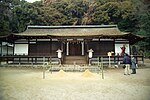
|
| Iwashimizu Hachimangū main shrine 10 buildings (石清水八幡宮本社10棟, iwashimizu hachimangū honsha jūtō)[50][51][52] | Iwashimizu Hachimangū | Honden: 11 ken wide, hachiman style,[ex 6] consisting of naiden (内殿) in kirizuma style[ex 16] and geden (外殿) in flowing roof style,;[ex 5] Sessha Takeuchi Shrine Honden: kirizuma style, behind the main Honden in the north-west; Mizugaki; Heiden with Buden: offering hall and hall for bugaku and kagura dance, kirizuma style; Rōmon; East Gate (Higashi-mon): kirizuma style; West Gate (Nishi-mon): kirizuma style; Kairō (3 parts): irimoya style,.[ex 8] all structures with hinoki cypress bark shingles except for the Kairō, the east and west gates which have hongawarabuki roofing.[ex 17] | early Edo period, 1634 | Yawata, Kyoto 34°52′47″N 135°42′00″E / 34.87972°N 135.70000°E | 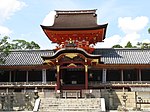
|
| East Main Hall (東本殿, higashi honden) and West Main Hall (西本殿, nishi honden)[nb 16][49][53][45] | Kamomioya Shrine or Shimogamo Shrine | either hall: 3 ken wide flowing roof style,[ex 5] hinoki cypress bark shingles. founded before the Heian capital, present buildings from 17th century. They are part of the World Heritage Site Historic Monuments of Ancient Kyoto (Kyoto, Uji and Otsu Cities). | end of Edo period, 1863 | Kyoto35°02′21″N 135°46′23″E / 35.03917°N 135.77306°E | 
|
| Main Hall (本殿, honden) and Associate Hall (権殿, gonden)[23][49][54] | Kamowakeikazuchi Shrine or Kamigamo Shrine | Both structures are identical in size and shape: 3×2, 5.9 m × 7.2 m (19 ft × 24 ft) flowing roof style[ex 5] with an extended roof in front to cover a prayer portico, hinoki cypress bark shingles. Honden and gonden were used alternatingly whenever one of them was being reconstructed or under repair. They are part of the World Heritage Site Historic Monuments of Ancient Kyoto (Kyoto, Uji and Otsu Cities). | end of Edo period, 1863 | Kyoto 35°03′38″N 135°45′10″E / 35.06056°N 135.75278°E | —
|
| Oratory (拝殿, haiden)[49][55][56] | Seiryōgū (清瀧宮) (Daigo-ji, upper Daigo (上醍醐)) | 7×3, overhang style (懸造, kake-zukuri), single-storied, irimoya style,[ex 8] entrance in the gable ends, 3 ken step canopy and nokikarahafu gable.[ex 11] It is part of the World Heritage Site Historic Monuments of Ancient Kyoto (Kyoto, Uji and Otsu Cities). | middle Muromachi period, 1434 | Kyoto 34°56′44″N 135°50′17″E / 34.94556°N 135.83806°E | 
|
| Karamon (唐門) | Toyokuni Shrine | four-legged gate[ex 15] gate with Karahafu gables[ex 13] at the front and back, irimoya style[ex 8] roof on the sides, covered with hinoki cypress bark shingles | Azuchi-Momoyama period, ca. 1598 | Kyoto 34°59′30″N 135°46′19″E / 34.99167°N 135.77194°E | 
|
| Main Hall (本殿, honden), Room of Stone (石の間, ishi no ma), Oratory (拝殿, haiden) and Music Chamber (楽の間, gaku no ma)[nb 17][23][57] | Kitano Tenman-gū | Honden: 5×4, irimoya style[ex 8] with a 3 ken aisle on the right side, covered with hinoki cypress bark shingles Room of Stone: 3×1, ryōsage style,[ex 9] covered with hinoki cypress bark Haiden: 7×3, irimoya style[ex 8] with a chidori hafu bargeboard[ex 10] on the front and a 7 ken step canopy Music Chamber: length 2 ken at the front, 3 ken at the back, width: 2 ken, irimoya style[ex 8] on one end, connected to the haiden, covered with hinoki cypress bark shingles All four structures are single-storied. This is the oldest extant gongen style[ex 12] complex. It was founded in the 10th century. |
Azuchi-Momoyama period, 1607 | Kyoto 35°01′53″N 135°44′06″E / 35.03139°N 135.73500°E | 
|
| Main Hall (本殿, honden)[58] | Yasaka Shrine | Honden: 7×6, gion style,[ex 18] irimoya style[ex 8] with hinoki cypress bark roofing | early Edo period, 1654 | Kyoto 35°00′13″N 135°46′43″E / 35.00361°N 135.77861°E | 
|
| Oratory (拝殿, haiden)[61] | Sakurai Shrine | 5×3, single-storied, kirizuma style[ex 16] with a hongawarabuki roof[ex 17] (except for the rear step canopy) | late Kamakura period | Sakai, Osaka 34°29′07″N 135°30′23″E / 34.48528°N 135.50639°E | 
|
| Main Hall (本殿, honden)[nb 18][23][63] | Sumiyoshi Taisha | 4×2, oldest example of the sumiyoshi style[ex 3] covered by hinoki cypress bark shingles. The shrine consists of four identical structures (positioned in "L"-shape), each 4.8 m × 8 m (16 ft × 26 ft). | late Edo period, 1810 | Osaka 34°36′45″N 135°29′35″E / 34.61250°N 135.49306°E | 
|
| Main Hall (本殿, honden)[65] | Uda Mikumari Shrine | three 1×1 kasuga style[ex 4] buildings with added hip rafter, covered with hinoki cypress bark shingles | late Kamakura period, 1320 | Uda, Nara 34°28′29″N 135°58′15″E / 34.47472°N 135.97083°E | 
|
| Main Hall (本殿, honden)[nb 19][23][67][68][69] | Kasuga Shrine | consists of four 1×1 shrine buildings 1.83 m × 2.64 m (6.0 ft × 8.7 ft) in kasuga style[ex 4] aligned in east–west direction on a grid frame, covered with hinoki cypress bark shingles; founded around mid 8th century, present form from beginning of Heian period, regularly demolished and reconstructed at 20-year intervals until 1863. It is part of the World Heritage Site Historic Monuments of Ancient Nara. | late Edo period, 1863 | Nara, Nara 34°40′54″N 135°50′55″E / 34.68167°N 135.84861°E | 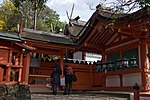
|
| Oratory (拝殿, haiden)[70] | Sessha Izumo Takeo Shrine (摂社出雲建雄神社, sessha izumo takeo jinja) (Isonokami Shrine) | 5×1, single-storied, kirizuma style,[ex 16] central passage with a karahafu gable,[ex 13] hinoki cypress bark shingles | late Kamakura period, 1300 | Tenri, Nara 34°35′51″N 135°51′07″E / 34.59750°N 135.85194°E | 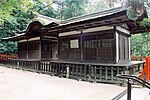
|
| Hakusan-dō (白山堂) and Kasuga-dō (春日堂)[nb 17][16][71] | Enjō-ji | two identical structures, each: 1×1, kasuga style[ex 4] with hinoki cypress bark shingles, together these are the oldest extant structures in the kasuga style | early Kamakura period, Antei era, 1227–1229 | Nara, Nara 34°41′45″N 135°54′56″E / 34.69583°N 135.91556°E | 
|
| Nageiri Hall (投入堂, nageiridō)[nb 20][72] | Okuno-in (奥院) (Sanbutsu-ji) | 1×2, single-storied, overhang style (懸造, kake-zukuri) with a flowing roof[ex 5] covered with hinoki cypress bark shingles | late Heian period | Misasa, Tottori 35°23′48″N 133°57′34″E / 35.39667°N 133.95944°E | 
|
| Main Hall (本殿, honden)[nb 21][23][73][74][75] | Izumo Taisha | 2×2, taisha style[ex 1] with hinoki cypress bark shingles; 10.9 m × 10.9 m (36 ft × 36 ft) and 24 m (79 ft) high (originally 48 m (157 ft)), slightly curved roof, three ridge billets, believed to have been the house of Ōkuninushi | middle Edo period, 1744 | Taisha, Shimane 35°24′07″N 132°41′07″E / 35.40194°N 132.68528°E | 
|
| Main Hall (本殿, honden)[nb 22][76] | Kamosu Shrine | 2×2, taisha style[ex 1] with tochibuki board roofing[ex 19] | Azuchi-Momoyama period, 1583 | Matsue, Shimane 35°25′32″N 133°05′03″E / 35.42556°N 133.08417°E | 
|
| Main Hall (本殿, honden) and Oratory (拝殿, haiden)[nb 23][23][79] | Kibitsu Shrine | Honden: 5 ken long (7 on the back), 8 ken wide, hiyoku irimoya style[ex 20] Haiden: 3×1, kirizuma style,[ex 16] connected to the rear of the honden roof, pent roof on three sides covered with hongawarabuki roofing[ex 17] Both structures are single-storied and covered with hinoki cypress bark shingles. At 14.5 m × 17.9 m (48 ft × 59 ft), the largest shrine structure in Japan |
middle Muromachi period, 1425 | Okayama 34°40′14.62″N 133°51′02″E / 34.6707278°N 133.85056°E | 
|
| main shrine: Main Hall (本殿, honden), Oratory (拝殿, haiden), Offering Hall (幣殿, heiden)[nb 1][nb 24][81][82][23][83] | Itsukushima Shrine | Honden: 8×4 (9 ken wide at back), ryōnagare style[ex 21] Heiden: 1×1, ryōsage style[ex 9] |
early Kamakura period and late Muromachi period, 1241 (Heiden and Haiden), 1571 (Honden) | Hatsukaichi, Hiroshima 34°17′45″N 132°19′12″E / 34.29583°N 132.32000°E | 
|
| main shrine: Purification Hall (祓殿, haraedono)[nb 1][nb 25][23][81] | Itsukushima Shrine | 6×3, single-storied, irimoya style,[ex 8] entrance in the gable ends, rear of roof is connected, hinoki cypress bark shingles. The shrine is a World Heritage Site. | early Kamakura period, 1241 | Hatsukaichi, Hiroshima 34°17′46″N 132°19′11″E / 34.29611°N 132.31972°E | 
|
| auxiliary Marōdo Shrine (Shrine for Guest Deities) (客神社, marōdo jinja): Main Hall (本殿, honden), Oratory (拝殿, haiden), Offering Hall (幣殿, heiden)[nb 1][nb 26][23][81] | Itsukushima Shrine | Honden: 5×4, ryōnagare style[ex 21] Heiden: 1×1, ryōsage style[ex 9] |
early Kamakura period, 1241 | Hatsukaichi, Hiroshima 34°17′48″N 132°19′12″E / 34.29667°N 132.32000°E | 
|
| auxiliary Marōdo Shrine (Shrine for Guest Deities) (客神社, marōdo jinja): Purification Hall (祓殿, haraedono)[nb 1][23][81] | Itsukushima Shrine | 4×3, single-storied, irimoya style,[ex 8] entrances on the gable ends, at the back connected to the haiden roof, hinoki cypress bark shingles. The shrine is a World Heritage Site. | early Kamakura period, 1241 | Hatsukaichi, Hiroshima 34°17′47″N 132°19′12″E / 34.29639°N 132.32000°E | 
|
| East Corridor (東廻廊, higashi kairō)[nb 1][nb 27][23][81] | Itsukushima Shrine | 45 ken long, single-storied, kirizuma style[ex 16] roof with hinoki cypress bark shingles. Extends from the entrance of Itsukushima Shrine past the Marōdo Shrine and the Asazaya to the purification hall of the main shrine. The shrine is a World Heritage Site. | Azuchi-Momoyama period, Eiroku to Keichō era, 1558–1615 | Hatsukaichi, Hiroshima 34°17′46″N 132°19′13″E / 34.29611°N 132.32028°E | 
|
| West Corridor (西廻廊, nishi kairō)[nb 1][23][81] | Itsukushima Shrine | 62 ken long, single-storied, kirizuma style[ex 16] gable at the eastern end and karahafu gable[ex 13] at the western end, covered with hinoki cypress bark shingles. The shrine is a World Heritage Site. | Azuchi-Momoyama period, 1563–1602 | Hatsukaichi, Hiroshima 34°17′44″N 132°19′10″E / 34.29556°N 132.31944°E | 
|
| Main Hall (本殿, honden)[nb 28][85] | Sumiyoshi Shrine | 9 bay wide structure consisting of five concatenated buildings under a single flowing roof,[ex 5] covered with hinoki cypress bark shingles, the front roof has five dormers with chidori hafu bargeboards[ex 10] | early Muromachi period, 1370 | Shimonoseki, Yamaguchi 33°59′59″N 130°57′23″E / 33.99972°N 130.95639°E | 
|
| Main Hall (本殿, honden)[nb 17][86][87] | Kandani Shrine | 3×2, oldest extant example of the flowing roof style[ex 5] covered with hinoki cypress bark shingles | early Kamakura period, 1219 | Sakaide, Kagawa 34°19′29″N 133°55′00″E / 34.32472°N 133.91667°E | 
|
| Main Hall (本殿, honden)[nb 2][nb 29][89] | Aoi Aso Shrine | 3×2, flowing roof style[ex 5] with copper-tile roofing, connected to the south with the heiden via the corridor | Azuchi-Momoyama period, 1610 | Hitoyoshi, Kumamoto 32°12′49″N 130°45′10″E / 32.21361°N 130.75278°E | —
|
| Corridor (廊, rō)[nb 2][89] | Aoi Aso Shrine | 1×1, single-storied, kirizuma style[ex 16] with copper-tile roofing, connects the honden in the north with the heiden in the south | Azuchi-Momoyama period, 1610 | Hitoyoshi, Kumamoto 32°12′49″N 130°45′10″E / 32.21361°N 130.75278°E | —
|
| Offering Hall (幣殿, heiden)[nb 2][89] | Aoi Aso Shrine | 5×3, single-storied, yosemune style[ex 22] on north side, connected to the haiden on the south side, thatched roof | Azuchi-Momoyama period, 1610 | Hitoyoshi, Kumamoto 32°12′48″N 130°45′10″E / 32.21333°N 130.75278°E | —
|
| Oratory (拝殿, haiden)[nb 2][89] | Aoi Aso Shrine | 7×3, single-storied, yosemune style[ex 22] with a 1 ken step canopy and a karahafu gable,[ex 13] thatched roof for the main building and copper-tile roof for the step canopy, connected in the north to the heiden | Azuchi-Momoyama period, 1611 | Hitoyoshi, Kumamoto 32°12′48″N 130°45′11″E / 32.21333°N 130.75306°E | 
|
| Rōmon (楼門)[nb 2][89] | Aoi Aso Shrine | 3×2 two-storied gate with entrance through the central bay, yosemune style,[ex 22] thatched roof | Azuchi-Momoyama period, 1613 | Hitoyoshi, Kumamoto 32°12′47″N 130°45′11″E / 32.21306°N 130.75306°E | 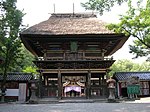
|
| Main Hall (本殿, honden), Offering Hall (幣殿, heiden), Oratory (拝殿, haiden)[91] | Kirishima-Jingū | Honden: 5×4, single-storied, irimoya style[ex 8] with a 1 ken step canopy 2×3, single-storied, ryōsage style;[ex 9] Haiden: 7×3, irimoya style,[ex 8] front with a chidori hafu bargeboard,[ex 10] 1 ken step canopy; all with copper-tile roofing |
mid Edo period, 1715 | Kirishima, Kagoshima 31°51′32″N 130°52′17″E / 31.85889°N 130.87139°E | 
|
| Main Hall (本殿, honden)[23][45][92][93] | Usa Shrine | hachiman style[ex 6], where both "buildings" are single-storied kirizuma style[ex 16] with hinoki cypress bark shingles. The rear part, called nai-in (内院), is 3×2, the front part, called ge-in (外院) is 3×1 with a 1 ken step canopy. | late Edo period, 1855 | Usa, Ōita 33°31′24″N 131°22′38″E / 33.52333°N 131.37722°E | 
|